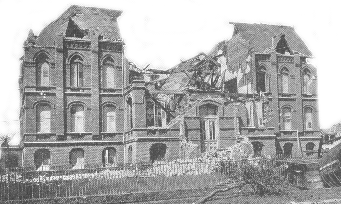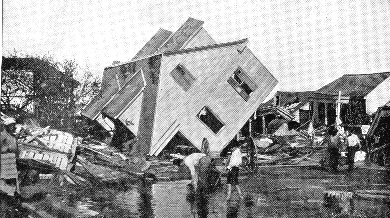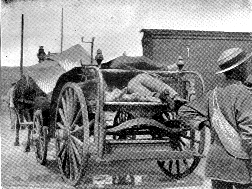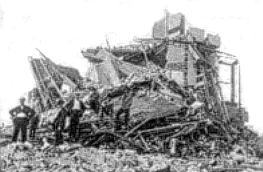AFTERMATH
Such a scene of desolation as met the eyes
of the people of Galveston when day dawned Sunday, September 9, has rarely
been witnessed on earth. Fifteen hundred acres of the city had been
swept clear of every habitation. Every street was choked with ruins,
while the sea, not contents with tearing away a great strip along the beach
front, had piled the wreckage in one great long mass from city end, to
city end.
.
 Destruction of Galveston Orphans' Home
.
Destruction of Galveston Orphans' Home
.
George MacLaine, of St. Louise, was in Galveston the night of the
storm. He wrote, "On Sunday morning, immediately after the storm
and as soon as daylight appeared, the scene o n the streets was one I shall
never forget. There were drunken women, almost nude, with their male
companions, also under the influence of liquor, parading the streets and
laughing and singing as if returning from a prolonged spree." He
also wrote, "There were some of the best citizens of Galveston hurrying
to and fro, asking this one and that one if they had heard anything of
their sisters, wives or some other member of their families. There
were others who had been presents when their families had perished, weeping
and wailing over their losses, young children crying for their parents
who had perished, parents crying for the loss of their children, and others
walking aimlessly about or standing around as if they were stunned."
.
 Scene at Avenue K and Sixteenth Street
House overturned by the wind.
.
The wreckage from Galveston littered the shore for miles and was 100
yards wide. For ten miles inland from the shore, it was a common
sight to see small craft, such as steam launches, schooners and oyster
sloops. The life boat of the life-saving station was carried half
a mile inland, while a vessel that was anchored in Moses Bayou lay high
and dry five miles up from La Marque.
Scene at Avenue K and Sixteenth Street
House overturned by the wind.
.
The wreckage from Galveston littered the shore for miles and was 100
yards wide. For ten miles inland from the shore, it was a common
sight to see small craft, such as steam launches, schooners and oyster
sloops. The life boat of the life-saving station was carried half
a mile inland, while a vessel that was anchored in Moses Bayou lay high
and dry five miles up from La Marque.
The great wharves and warehouses along the
bay front were a mass of splintered, broken timbers. The bay was
strewn with overturned and stranded vessels.
Beneath these masses of broken buildings, in
the streets, in the yards, in fence corners, in cisterns, in the bay, far
out across the waters of the mainland shores, everywhere, in fact, were
corpses. Added to the horror of so many corpses was the presence
of carcasses of thousands of horses, cattle, dogs and other domestic animals.
.
 Fire Department taking bodies to a morgue.
.
Fire Department taking bodies to a morgue.
.
Fifteen thousand person were homeless. Bodies were piled everywhere.
By Monday morning, 24 hours after the storm, the stench from the dead
was unbearable. The triumvirate ruling the city pressed citizens
into services to take the dead out in barges and bury them at sea.
That that time, it was impossible to give other burial.
Dead fish were given away by the thousands to all who come for them.
Animals were dumped into the bay, which go out with the tide, and coming
ashore by the hundreds at Bolivar Peninsula. Parties started to bury
them, but the few people on the peninsula found it impossible. After
complaints were made, the dumping soon stopped, and the carcasses were
cremated.
Railroad bridges across the bay were either
wrecked or likely to be destroyed with the weight of a train on them.
The approach to the wagon bridge were gone, and the drawbridges over Clear
creek and Edgewater were gone.
.
 Lucas Terrace, where twenty-seven persons were
saved in one little room that remained standing.
.
The Opera House, City Hall, Masonic Temple, Moody's Bank Building, Knapp's
publishing house, and Ritter's saloon and restaurant, on the Strand, were
wrecked. Seven dead bodies were pulled from beneath the wreckage
at Ritter's saloon.
Lucas Terrace, where twenty-seven persons were
saved in one little room that remained standing.
.
The Opera House, City Hall, Masonic Temple, Moody's Bank Building, Knapp's
publishing house, and Ritter's saloon and restaurant, on the Strand, were
wrecked. Seven dead bodies were pulled from beneath the wreckage
at Ritter's saloon.
Galveston's great open-air show-place was the Garten Verein, which
was wiped out of existence. Among the debris was found many bodies.
Return to Menu / Next
Return to For Old Times Sake Home
Page




